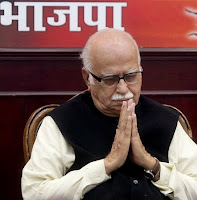
“A house divided against itself cannot stand.”
[Abraham Lincoln]
As the BJP’s central office-bearers and members of the so-called ‘core group’ prepare to meet in Shimla from August 19 to 21 for the much-publicised ‘chintan baithak’, two developments have grabbed media attention.
The first pertains to LK Advani. On August 7, Advani held the customary ‘last day of the session’ Press conference, although this ritual has lost its relevance given the extensive coverage of parliamentary proceedings by media, especially television channels. As expected, mediapersons were least interested in the BJP’s performance in Parliament or issues of governance and policy. They were more interested in what has come to be known as the ‘leadership issue’ of the BJP, also described as the BJP’s ‘crisis of leadership’.
Advani was asked what was the road ahead for him. Before he could respond, his deputy, Sushma Swaraj, grabbed the microphone and said, “I will answer this question. He was ‘elected’ leader of the parliamentary party for a full term of five years, not with any deadline.”
But was he remaining in the post of Leader of Opposition reluctantly or under pressure? Mr Advani replied unambiguously: “Whatever I agree to is of my own volition. The kind of political life I have had and the kind of appreciation I have had from the country, I don’t do anything reluctantly.”
There is no ambiguity here. Advani will remain Leader of Opposition in the Lok Sabha. The question of his making an exit in the near future does not arise. The impression conveyed at the Press conference is that unless someone else takes over from him, a possibility ruled out categorically, he will lead the party in the 2014 election.
On Monday, August 10, RSS Sarsanghachalak Mohan Bhagwat met Advani in Delhi. It was a one-on-one meeting and apart from them, and anybody else to whom they may have spoken, nobody knows what transpired. But over the past three days, media has been claiming that Advani was confronted on his decision to stay put instead of stepping down for someone else to take over from him. How far this is true is anybody’s guess.
The second development pertains to former Chief Minister of Rajasthan Vasundhara Raje. The BJP’s ‘central leadership’ wants her to step down as Leader of Opposition in the Rajasthan Assembly for two reasons: To own up responsibility for the party’s defeat in the Assembly election; and, to heal the deep fissures in the State party unit on account of reported differences between her and the State unit president who has been hand-picked by Delhi.
Vasundhara is no pushover. She was formally and unanimously elected leader of the legislature party in accordance with the BJP’s constitution after the Assembly poll. She has decided to fight it out, and to demonstrate that she has the majority of the BJP legislators with her, will parade 57 of the 78 MLAs in Delhi before those who have issued marching orders to her. In brief, we haven’t heard the last word yet.
Vasundhara is not alone in being asked to carry the can for the party’s poor electoral performance which was entirely on account of infighting, motivated dissidence and poor organisation. BC Khanduri has had to step down as Chief Minister of Uttarakhand for the same reason.
It can be argued that State leaders must be held accountable for the party’s electoral performance and that they cannot wash their hands of responsibility. As a principle, this is unassailable. But must accountability stop with State level leaders? What about the accountability and responsibility of central leaders who led from the front?
The verdicts in Rajasthan and Uttarakhand, we are told, amount to a rejection of the leadership of Vasundhara and Khanduri; that voters have refused to repose faith in them; and, that they failed to enthuse party cadre and sympathisers as well as hold together factions and groups.
If this is true, what does the national verdict amount to?
Does the stunning 3.32 per cent dip in the BJP’s national vote share reflect popular rejection of the party’s frontline leaders? Who should be held accountable for the fact that the party’s vote share decreased in 21 States? Who is responsible for the national tally falling to 116 seats, 22 short of the 2004 tally? Is the accountability criterion not applicable while judging central leaders?
Three months after the Lok Sabha election results were declared these questions have not disappeared, much as the central leaders of the party would want them to. On the contrary, they have gained currency following the efforts to hold Vasundhara ‘accountable’ for the electoral rout in Rajasthan while glossing over the rout at the national level.
The upcoming ‘chintan baithak’ should be seen in the context of these and other questions that have been raised since May 16. To avoid the questions would render the Shimla conclave a futile exercise.
The BJP’s leaders need to focus on five key areas to revive and rejuvenate the party:
Ideology
Organisation
Policy and programme
Governance
Performance of MPs/MLAs
But any discussion on these and related issues will be meaningless unless the credibility deficit of the leadership is resolved. Leadership flows from clarity of thought and ideas. Clarity flows from political determination to act decisively. Political determination flows from courage and conviction.
At the moment, what is most visible is the absence of courage and conviction. The rest follows.
PS: Has anybody quite figured out the purpose of releasing the Urdu edition of My Country My Life?
